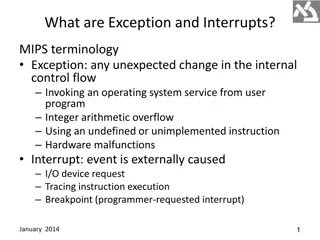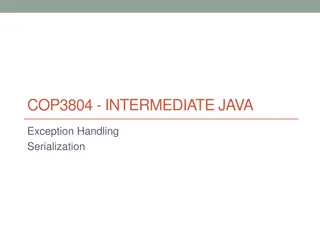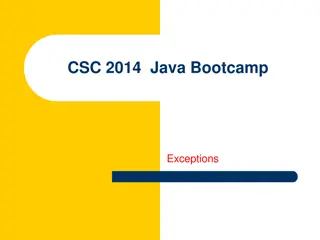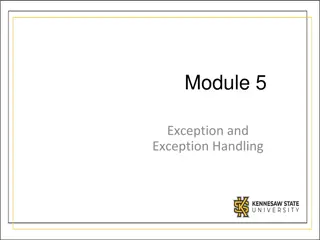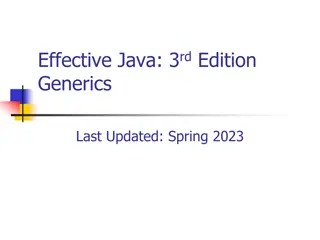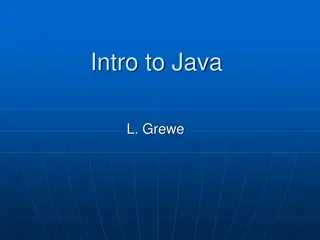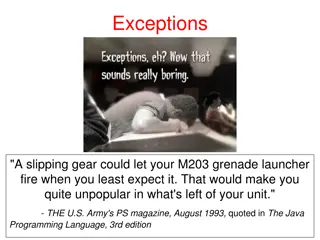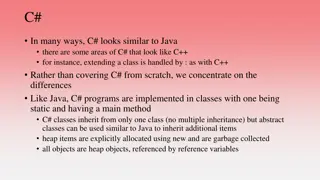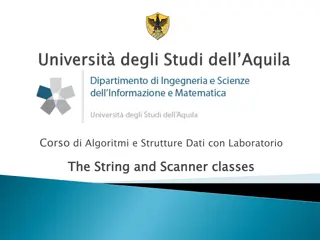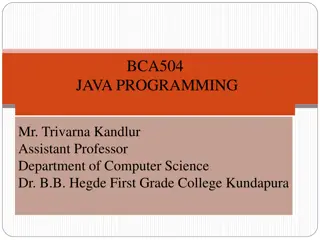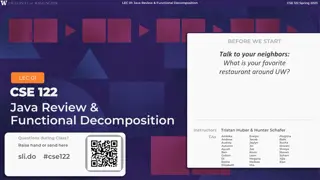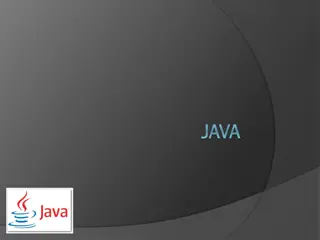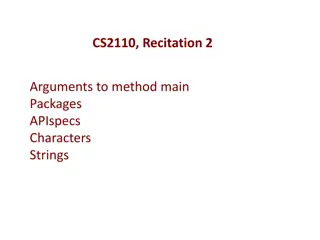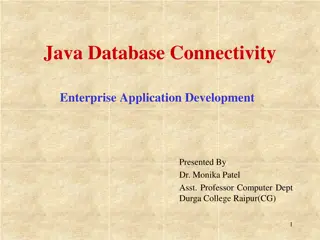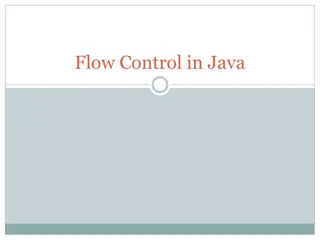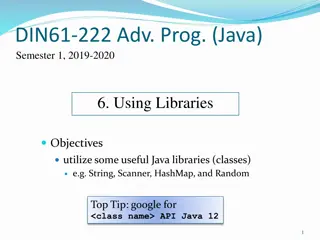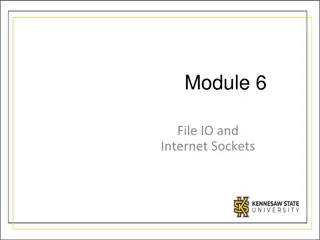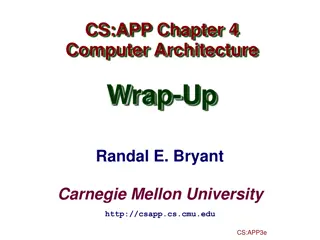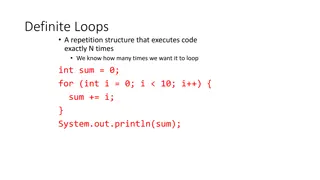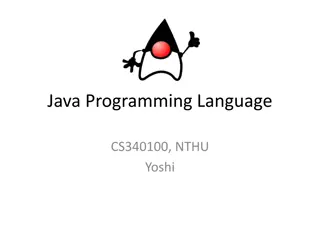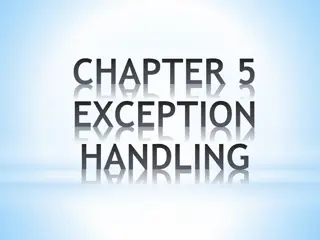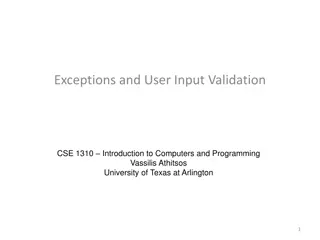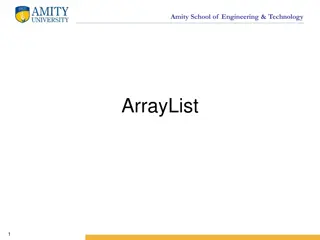Understanding Java Exception Handling
Java provides a way to handle run-time errors through exceptions, which are objects of the class Exception or its subclasses. By using exception handlers, programmers can catch and manage exceptions to prevent abnormal termination of the program. Java's exception hierarchy includes Throwable, which has two main subclasses - Exception (catchable) and Error (uncatchable). The 'try' block is used to attempt risky code, and 'catch' blocks help in handling specific types of exceptions that may occur.
Download Presentation

Please find below an Image/Link to download the presentation.
The content on the website is provided AS IS for your information and personal use only. It may not be sold, licensed, or shared on other websites without obtaining consent from the author. Download presentation by click this link. If you encounter any issues during the download, it is possible that the publisher has removed the file from their server.
E N D
Presentation Transcript
Exceptions and Exception Handling What happens when a program has a run-time error? In most cases, the program terminates abnormally, possibly displaying a cryptic message to the user (or no message at all) in unix, such errors often place core dumps in your directory As programmers, we should try to ensure this doesn t happen, how? In Java, most types of run time errors cause exceptions to be generated In Java, exceptions are objects of the class Exception or one of its subclasses A method is said to throw an Exception You can write code to catch an Exception This code is called an exception handler, and with the handler, you can take care of the error so that the program does not terminate abnormally
Exception Class Hierarchy Throwable is a subclass of Object There are two types of throwable objects, Exceptions which can be caught and handled Errors which cannot be caught Underneath Exception, there are many predefined subclasses and subsubclasses ClassNotFoundException ArithmeticException IOException Exception NullPointerException RuntimeException IndexOutOfBoundsException Many more classes IllegalArgumentException Object Throwable Many more classes LinkageError VirtualMachineError Error Many more classes
5 New Java Instructions try we indicate a block in which we want to attempt something the code we put in the try block might raise an exception try { /*place code here to try*/ } we can place other code in the method before and/or after the try block, in essence we are only putting risky code in the try block if an exception arises in the try block, transfer control immediately to the most closely related catch block (see the next slide) if no exception arises, execute the entire try block, ignore any catch blocks when the try block is done and continue with the rest of the method (if any code follows the try block) without the try block, a thrown Exception will terminate this method
Continued catch we follow any try block with one or more catch statements of the form catch(ExceptionType e) { } each catch compares the thrown Exception (the parameter) against the type specified on a match, execute the catch block and leave the group of catch blocks if it doesn t match, continue to work through each remaining catch until one is capable of catching the thrown Exception catch (ArithmeticException e) { } catch (NullPointerException e) { } catch (Exception e) { } here, we will catch an ArithmeticException in the first block, a NullPointerException in the second, and any type of Exception in the third (it acts as a default or catch all catch block) Note: you cannot have a try block without at least 1 catch (or a finally clause discussed later)
Continued throw we can raise our own Exception by using a throw statement any throw should be placed inside an if statement as we only want to throw an Exception under special circumstances we indicate the Exception to be thrown, usually by creating/instantiating a new Exception if(divisor == 0) throw new ArithmeticException( Divide by 0 error ); most Exception classes are implemented to receive the String param and output it as a notification to the user (we could do more than this) the throw statement immediately terminates the method containing it, and control is transferred to the calling method which will hopefully catch this exception throws added to a method header to indicate that the method has one or more throw statements this is known as declaring exceptions in which you specify any and all Exceptions that this method can throw finally discussed later
public class Exception2 { public static int divide (int a, int b) throws ArithmeticException { if(b==0) throw new ArithmeticException ("Cannot divide by 0"); else return a/b; } public static void main (String[ ] args) { int x=5, y=0, z; try{ z=divide(x,y); } catch(ArithmeticException e) { System.out.println(e); } } } Two Examples public class Exception1 { public static void main(String[ ] args) { int x=5, y=0, z; try{ z=x/y; } catch(ArithmeticException e) { System.out.println ("Arithmetic Exception Raised, cannot continue"); } } } With the approach on the right, we could also just use an if statement in main if(y==0) System.out.println( error ); else z=x/y;
What Kinds of Exceptions Are There? Exception Description ArithmeticException Arithmetic error such as divide by zero and overflow ArrayIndexOutOfBoundsException NegativeArraySizeException For array index < 0 or >= array size A negative array size when instantiating BufferOverflowException, BufferUnderflowException When putting or getting from a full/empty buffer ClassCastException Invalid cast ClassNotFoundException Attempt to use an undefined class FileNotFoundException For file I/O IllegalArgumentException Argument cannot be used in method call InsufficientResourceException Some resource (buffer, memory, bandwidth) has insufficient capacity to continue InterruptedException Thrown when a thread is interrupted incorrectly IOException Error when handling I/O (including file I/O) NullPointerException Occurs when passing a null pointer a message NumberFormatException Invalid conversion of String to numeric type StringIndexOutOfBoundsException Like the array exception except for Strings TypeConstraintException A dynamically checked type is illegal
More Details on Exceptions All Exceptions and Errors are Throwable It is usually the JVM that will throw exceptions and errors that is, the process of throwing an Exception is done for us for all built-in types of Exceptions so that we do not need to use throws statements you can include your own throw statements especially if you are using your own type of Exception or in circumstances that the JVM may not notice While Errors can be caught, just like Exceptions, the Error will usually not allow your program to resume after the catch block executes your Error exception handler might be limited to notifying the user and gracefully terminating the program (e.g., closing any open files)
Continued Errors are generally caused by system errors, not program errors Exceptions are usually caused by your program e.g., user inputs the wrong type of variable such as a number instead of a String or because a buffer overflow if you do not check the array s size before adding to it, or because you are trying to divide by 0 Uncaught Exceptions cause the program to terminate Another category of Exception is the CheckedException this subclass of Exception requires that the programmer implement some mechanism to handle the Exception you can do this either by implementing try and catch blocks (the code that raises the CheckedException is placed in a try block, the CheckedException must then be caught by a catch block afterward) or by throwing the exception out of this method to another method (see next slide)
Checked Exceptions A CheckedException is associated with a class If you use the class, you have to handle the exception many I/O classes require checked exceptions To handle the CheckedException either through a try-catch pair like try {// code that uses this class } catch(CheckedExceptionTypee) { } or by throwing the CheckedException type out of this method add throws ExceptionType to the method header this second approach is essentially passing the buck to somewhere else and is known as a chained exception when you throw it to be caught elsewhere ultimately some code must be placed in a try block with an associated catch block to catch this type of Exception if no such method exists in the chain of method calls, your program terminates with a runtime exception (error) NOTE: you cannot declare an exception in an overriden method in which the parent class method also did not declare that exception
Throwing Versus Catching In most cases, the JVM will throw an exception If you suspect an exception might arise, place the code in a try block and follow it with a catch for each type of exception that might be thrown If you prefer to throw your own exception and handle it elsewhere Add throws ExceptionType to the method header Add an if statement in the method that will test for the exception case e.g., if(divisor==0) throw You can either declare and instantiate a variable of the ExceptionType or just throw a new exception ArithmeticException e = new ArithmeticException( ); throw e; throw new ArithmeticException( );
Catch Blocks If an Exception is thrown from a try block, the try block terminates immediately Catch blocks are searched from first to last in order after the try block for the first block whose parameter type matches the Exception If the Exception is a subtype of the Exception type listed as a parameter in the catch block, it will be caught there e.g., catch (RuntimeException e) { } will catch ArithmeticException, NullPointerException, IndexOutOfBoundsException, etc, but not IOException which is not a RuntimeException Note that the compiler will flag an error if a catch block that contains a superclass appears before a catch block that contains one of its subclasses
Continued If no catch matches the thrown Exception or there are no catches here after the try block Then the method terminates and the calling method resumes but the calling method has an Exception to handle, so the catch blocks which appear after the try block holding the method call are checked in order The search for a catch block continues until one is found and if there are none in this method (or if none match) then this method terminates and we resume the calling method this is known as propagating the exception This process of searching for a catch block continues until the exception is caught or we reach main if not caught in main, the program terminates with an Exception (this is to all intents and purposes a run-time error NOTE: In Java 7, you can specify multiple exception classes in the parameter list of a catch block, separating the types by | catch (ExceptionType1 | ExceptionType2 | ExceptionType3 ex) { }
Example If method 3 throws an Exception3 it is caught in method2 and statement6 executes (but not statement5) an Exception2 it is caught in method1 and statement4 executes (but not statement5 or statement3) an Exception1 it is caught in main and statement2 executes (but not statement1) any other type of exception not caught at all and the program terminates before statement5 (statements3,4,1,2 are all skipped) An exception is thrown in method3 try try try catch catch catch Call Stack method3 method2 method2 method1 method1 method1 main method main method main method main method
Exception Messages When we throw an exception, we usually place a String as the parameter to the Exception s constructor This String is then used as output to the user to notify of the Exception the class, method, line, and Exception raised Exception methods: getMessage( ) returns the String toString( ) returns the full name of the exception class, a colon, and the result of getMessage( ) printStackTrace( ) prints the stack trace (the methods on the runtime stack) getStackTrace( ) returns the runtime stack as an array The output of a typical exception is java.lang.ExceptionName: linenumber at Class.method(Class.java:linenumber) at (for each method on the runtime stack) Example (see code on page 530-531) java.lang.ArrayIndexOutofBoundsException: 5 at TestException.sum(TestException.java:24) at TestExeption.main (TestException.java:5)
The finally Clause What if you want to ensure that some code is executed no matter if an exception is raised and handled, raised and not handled, or not raised? Use finally After all catch blocks you can add an optional finally clause The order of execution is as follows No exception raised: try concludes, finally executes Exception raised and caught by a catch block: rest of try block skipped, catch executed, finally executed Exception raised but not caught: rest of try block skipped, finally executed, transfer control to calling method (or terminate if the try block is in main) NOTE: the finally block executes even if a return statement is reached in earlier code (such as in the try block) Use the finally clause to clean up such as by closing files You can even omit catch blocks if you have a try and finally
Should You Use throw? Note that the use of throw to throw an Exception to be caught later is typically embedded in an if statement if(divisor==0) throw new ArithmeticException( ); x=y/divisor; You could just as easily use the if-else statement to test the condition and output an error message instead of throwing if(divisor==0) System.out.println( cannot divide ) else x=y/divisor; So why use the throw statement? For simple errors, stick with the if-else approach What about an array subscript out of bounds? Should you test the index (if(index>=0&&index<n) )? By throwing and catching, you are using more resources
Rethrowing an Exception What happens if a catch block cannot adequately handle a thrown Exception which it catches? Consider for instance that a catch block is going to catch an ArithmeticException and try to handle it as if it were a division by 0 error but if the ArithmeticException were caused by some other reason, this catch block is not suitable A catch block can rethrow an Exception Such a throw causes this method to terminate and the calling method will attempt to catch the exception note: any later catch blocks in this method do not get a chance to catch this exception even if they might because they are of a more general Exception type
public class Exception2 { public static void method1(int x) try{ int y=x/0; } catch(ArithmeticException ex) { System.out.println("arithmetic exception"); throw ex; } catch(Exception ex) { System.out.println("exception"); } } { Example Thrown from ArithmeticException in method1 to ArithmeticException in main } public static void main(String[] args) { int a=1; try { method1(a); } catch(ArithmeticException ex) { System.out.println("in main"); } }
Chained Exceptions You can add an existing Exception to another Exception catch(SomeException ex) {throw new AnotherException( explanation , ex); } In this way, the catch can catch the first Exception and then throw a second Exception which includes the message of the first caught message The output is then chained together as in java.lang.AnotherException: explanation at Class.method(Class.java:linenumber) Caused by: java.lang.SomeException: original explanation at Class.method(Class.java:linenumber)
Defining Your Own Exceptions As Exception is a class, you can extend it Or you can extend a subclass such as IOException, RuntimeException or ArithmeticException for instance, imagine that your particular program uses a special range of values and you want to indicate an whether a computation is outside of that range so you extend ArithmeticException to a new Exception, OutsideAcceptableRange Usually your own Exception class will consist only of a no-arg constructor and a constructor which receives a String parameter If you are storing data in the Exception then it may also require getter and setter methods
public class OutOfRangeException extends ArithmeticException { int value; String varname; public OutOfRangeException(String name, int x) { super( Out of range value: + name + has value + x); value=x; varname=name; } Example public int getValue( ) { return value; } public String getVarName( ) { return varname; } } // somewhere in your program if(x>MAX) throw new OutOfRangeException( x , x); else ... NOTE: it is best to extend Exception, not RuntimeException because RuntimeException is unchecked and it is better to create a checked exception instead
I/O and Exceptions We wrap up this chapter by briefly looking at file I/O and keyboard input To perform file I/O, we use the File class (part of java.io) The File class constructor receives the filename as an argument This may be an absolute path or a relative path remember that Windows is not case sensitive, Linux/Unix is, also in Windows, use \ and in Linux/Unix use / for each subdirectory a filename stored as a literal String would have to use \\ instead of \ for subdirectories because \ is the escape character Although the File class does not cause checked exceptions, it is best to always include your file I/O handling code in try/catch blocks This ensures that the program does not terminate abnormally if the user makes a mistake with a file name (e.g., file doesn t exist)
Creating an instance of File does not create file but instead instantiates a File variable to access the contents of a file but if the file does not exist, you will cause exceptions to be raised when you interact with that object use exists to test to see if the file exists
Scanner The Scanner class (part of java.util) provides general purpose input methods You can input from keyboard or from a File To use a Scanner: Scanner var = new Scanner(System.in); //keyboard Scanner var2= new Scanner(new File(filename)); //file Once you have instantiated the Scanner variable, you can pass it messages such as hasNext( ) returns true if another input is available next( ) retrieve next input (as a String) nextInt( ) retrieve next input as an int nextDouble( ) retrieve next input as a double etc. for the various types (byte, short, long, float nextLine( ) retrieve entire line as a String useDelimiter(pattern) use the String pattern as a delimiter (defaults to any white space)
File Output We use the PrintWriter class (part of java.io) to output text to a file Unlike Scanner and File, PrintWriter does cause Checked Exceptions so we need to handle an IOException (such as using try-catch blocks) First, instantiate your File objects File foo=new File( somefile.txt ); if(foo.exists( )) System.out.println(foo.getName() + already exists, aborting ); else { } Now instantiate your PrintWriter object PrintWriter pw = new PrintWriter(foo); Next, pass pw your messages for output pw.print(item) item can be a String, char, char array, int, long, float, double or boolean There is println which is the same but adds an end of line character ( \n ) at the end of the output There is also a printf that allows you to format your output (see section 3.16 for details) Close the PrintWriter when done ( pw.close( ); )
import java.util.*; import java.io.*; Example { public class FileCopier { public static void main(String[] args) String line; try { File input=new File("inputfile.txt"); Scanner s=new Scanner(input); File output=new File("outputfile.txt"); if(output.exists()) System.out.println ("Output file already exists, aborting..."); else { PrintWriter pw=new PrintWriter(output); while(s.hasNext()) { line=s.nextLine(); pw.println(line); } s.close(); pw.close(); } } catch(IOException e) { System.out.println(e); } } }
Miscellany We want to let the user input a file name We could use a Scanner and have the user type in the file name but we can also open a file chooser box using JFileChooser (from javax.swing) JFileChooser jfc=new JFileChooser( ); we can place a String to serve as an initial directory path in the parens jfc.showOpenDialog(null); File f = jfc.getSelectedFile( ); We can also obtain files from the web using the URL class (from java.net) The URL constructor receives the URL as a String but can throw a MalformedURLException to be caught We can also use a URL to create a Scanner URL u = new URL( ); Scanner s = new Scanner(u.openStream( ));


